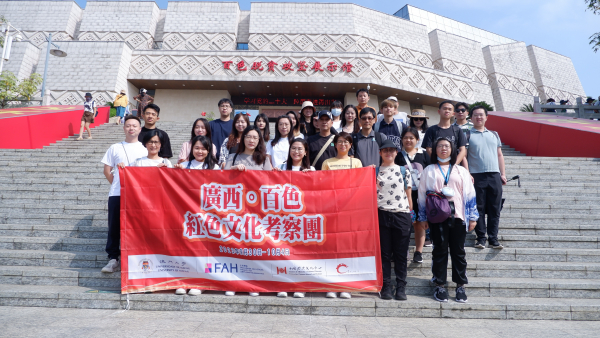From 30th September to 4th October 2023, the “Guangxi •Baise Red Culture Study exchange trip”, jointly organized by the University of Macau (UM), the Faculty of Arts and Humanities ( FAH) and the Centre for Chinese History and Culture ( CCHC), was carried out successfully. With the great support from the UM, the study group received warm welcome from the people of Guangxi. There were 29 students and teachers from the postgraduate programme of Chinese History and Culture of the UM, Macao Base for Primary & Secondary Education in Humanities & Social Science Base and Macao Chinese Culture Promotion Ambassadors. The purpose of this study group is to allow Macao teachers and students to go close to the mainland of China, to experience the vastness of the country’s culture, and to strengthen the sense of national awareness and national pride. During the five days, the team toured Baise and Guilin successively, visited the Baise Uprising Memorial Park and Yue Dong Provincial Guild, as well as Elephant Trunk Hill, Longji Terraced Fields and Jingjiang Princes’ Palace, etc., to gain an in-depth understanding of the red culture of Guangxi as well as the characteristics of the local folk culture.

On the National Day, the study group visited the Yue Dong Provincial Guild, which was the command headquarters of the Baise Uprising. The brick and wood structure of the ancient building has the artistic tradition and style of the ancient architecture of the South. Later, they visited the large-scale Baise Uprising Memorial Park, which comprehensively displays the narratives of important figures and events related to the Baise Uprising, including the Baise Uprising Memorial Hall, the You River Ethnic Museum, the Baise Uprising Memorial Monument, the Red Army Bridge, the Nange Pavilion, and the Friendship Garden of the Youths of Guangdong and Guangxi, among other important revolutionary historical and cultural resources. The visit allowed many teachers and students from Macao to deeply understand the difficulty of exploring the revolutionary road with Chinese characteristics, and the excellent qualities of the revolutionary team, such as “Perseverance, seeking truth from facts, relying on the masses, and united struggle “, deeply moved the team and gave rise to a sense of national pride.

On 2nd October, the team went to the banks of Guilin’s Li River to see the Elephant Trunk Hill spectacle, The Tabo Pagoda of the Pohyonsa Buddhist temple, the Sanhua Rice Aroma, and the Love Island. Later, they explored the historical and cultural landscape of the Song Dynasty Dong Zhen Gate and the Song Dynasty City Wall remains on the north side of Mulong Lake. From the Baise Uprising a hundred years ago to today’s celebration of the National Day in Guilin, through the mists of time and space of more than 90 years and the ancient and modern gap. We can still clearly see the Guangxi this piece of red land on the lasting charms magnificent picture: from becoming a brigade of the Central Red Army to hold on to the right side of the Youjiang for 20 years, the red flag will not fall, the fire will not go extinct, and are always vividly demonstrated the martyrs of the uprising and the heroism of the saints of the past and the spirit of struggle.

On 3rd October, the team came to Longji in Guilin and visited the World’s Crown of Terraces Longji Terraces and Ping’an Village, enjoying the beautiful scenery of Ping’an Terraces, the Seven Stars Around the Moon, and the Nine Dragons and Five Tigers and so on. During the Golden Autumn Festival, we saw rice ears full of rice like bowing down in salute, just as the people of Guangxi are generally warm and hospitable.

On 4 October, the study group toured one river and four lakes in one day, taking a cruise on the inner section of Guilin’s Li River city, Rong Lake, Gui Lake, Shan Lake and Mulong Lake to see the green mountains and green waters of Guilin. Finally, the team made an in-depth inspection of Duxiu Peak, a 5A National Scenic Area, and the Jingjiang Princes’ Palace. This was the residence of King Zhu Shouqian of Jingjiang, a vassal king of the Ming Dynasty, and is surrounded by one of the best-preserved Ming Dynasty city walls outside the country. The group toured the area, experiencing the Fu and the imperial examinations, travelling through the Ming and Qing dynasties, and seeing the dilapidated walls after the overthrow of the Qing dynasty and restoration of the Ming dynasty and Anti-Japanese War periods. Only the Jingjiang Princes’ Palace under the Duxiu Peak has survived all the ups and downs of the past and has been preserved by the feng shui and Chinese culture trace of the people as the time goes by.

Through this Guangxi-Baise Red Culture Study Group, Macao teachers and students were able to visit the significant history of ancient and modern times, and gained an in-depth understanding and experience of the essence of Guangxi culture, further enhancing their understanding of Guangxi culture. At the same time, this activity also promoted academic exchanges and co-operation between Macao and Mainland cities, promoted Macao’s education and the inheritance and development of local culture, and expanded the influence of Chinese history and culture.
